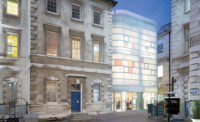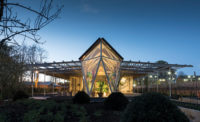London, England
During the last few months of Maggie Keswick Jencks’s life, she and her husband, the architecture critic and landscape designer Charles Jencks, hatched the idea of cancer-caring centers. Located adjacent to hospitals, patients could casually enter these welcoming, almost domestic spaces to access the help they couldn’t find at the neighboring institution.
In August 1994, Western General Hospital, in Edinburgh, Scotland, allowed Keswick Jencks to develop one of these unprecedented facilities. She died in July 1995 and did not see that cancer-caring center open in a historic stable block near Western General in November of the following year. “She never imagined more than one,” adds Jencks, who named the center in Maggie’s honor.
If Keswick Jencks could not have conceived of multiple facilities, then it is even more remarkable that Frank Gehry, Zaha Hadid, and Richard Rogers designed three of the six Maggie’s Centres built today. “Our first two buildings were by architects we knew, who were small in size but good and committed, and who could do conversions,” Charles Jencks says of architects Richard Murphy and David Page. But then Gehry presented a series of schemes for a building in Dundee, Scotland, and “the press in Britain went crazy with excitement.”
“From that we realized that architects both well-known and unknown could be of great help in not only designing a building, but also giving us a certain kind of importance within the British system.”
Jencks admits that the architects who design Maggie’s Centres negotiate a kind of Catch-22, as they are encouraged to create strongly expressive buildings while paying heed to the relaxed, homey atmosphere Keswick Jencks described in her original brief. Although their design schemes share several features, such as central kitchens and transformable open floor plans, Jencks says the architects of existing buildings and works in progress have resolved this contradiction in unique ways.
Such variety reflects the hybridized qualities of Maggie’s Centres. “It’s an institution that isn’t an institution, a house that isn’t a home, a museum that is not an art gallery, and a church that is nonreligious,” Jencks observes of the building type, instead calling it an “architecture of hope.” A book by that name will be available Stateside later this year.



Post a comment to this article
Report Abusive Comment